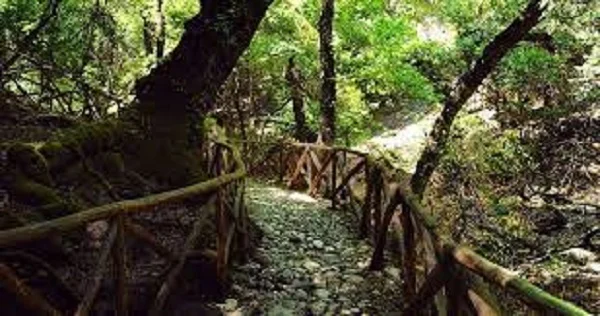Valley of the Butterflies on the island of Rhodes

The Valley of the Butterflies is a unique nature reserve located in Rhodes, about 27 km from the capital. This is not a valley but a narrow park stretching to the top of a hill along the gorge. Thousands of butterflies fill it with life and movement. You can find small waterfalls, bizarre rocky ledges, and minor reserve inhabitants in some places: crabs, lizards, and rare birds. The air is saturated with the aroma of vanilla – the trees of the styrax genus growing here emit odorous resins. It is they who attract butterflies of the bear family, who flock here from all the surroundings.

The famous Valley of the Butterflies of Rhodes ( Greece ) island is home to a special species of endemic moths. The valley is formally called Petaloudes, but it is called The Valley of the Butterflies.
Why are there so many butterflies

The Petaloudes Valley is home to Europe’s only natural forest of the Liquidambar Orientalis. The scent of these trees attracts an endemic subspecies of the Jersey tiger moth called Panaxia Quadripunctaria. Simply put, they are large moths.
A huge number of butterflies congregate in this small valley, covering almost all visible surfaces like a living blanket.
Each year, the spectacular migration of these butterflies to the valley begins around the end of May, after the rainy season, when the butterflies emerge from their pupae. Attracted by the scent of trees, they fly inland, sometimes traveling tens of kilometers towards the valley.
Once in the valley, flocks of butterflies cover all surfaces, from lush foliage to rocks of all shapes and sizes. They prefer to sleep on the shady sides of trees or at the roots.
History
The first mention of the valley dates back to 1728. Then it was named after a slave named Pelekanos, who committed suicide here because of unrequited love. In the early 90s, butterflies appeared in the valley, so the name was changed to “Valley of the Butterflies.” But the river flowing in the valley is called “Pelekanos.”
According to other sources, in 1930, the Italians brought butterflies to the valley. However, old-timers claim that butterflies were here a long time ago.
Due to the dense vegetation, the valley was inaccessible, so, until 1928, the Italians living in the Kalamonas region made it accessible.
Valley of the Butterflies and tourists

Tourists are advised to enjoy the surreal views in maximum silence, as loud sounds can scare butterflies.
Keeping quiet isn’t just a favor for insects. It is vital to the survival of this moth species. Scaring them and making them fly more than they need to is a surefire way to reduce their population. This is because butterflies have no stomachs and cannot eat. They only survive on the fatty deposits that accumulate in the caterpillar stage. Therefore, they need to save energy.
If you scare butterflies, they begin to fly away ahead of time. That is why they can exhaust their energy reserves before they can reproduce offspring. And these are already disastrous consequences for the colony. In fact, due to the large number of tourists who visit the Valley of the Butterflies every year, the endemic population of the Jersey tiger moth has been severely affected.
Many visitors ignore the advice of staff and guides and clap their hands or whistle to see flocks of butterflies take off. This is a truly impressive sight as the flap of the wings allows viewers to see the orange-colored fenders
Pops and whistles create ultrasonic sounds similar to the sounds of bats. The butterflies feel threatened and try to fly away. Many die of shock or exhaustion while trying to escape or due to collisions with rocks and trees. They need to stay in the trees because they have to keep up the strength for the long journey in September. “
The butterflies mate in late August and September. The females then leave the valley, traveling long distances in search of dark and safe places. There they lay their eggs before their natural life cycle ends. When the rainy season ends, a new generation of butterflies appears, and the cycle repeats.




